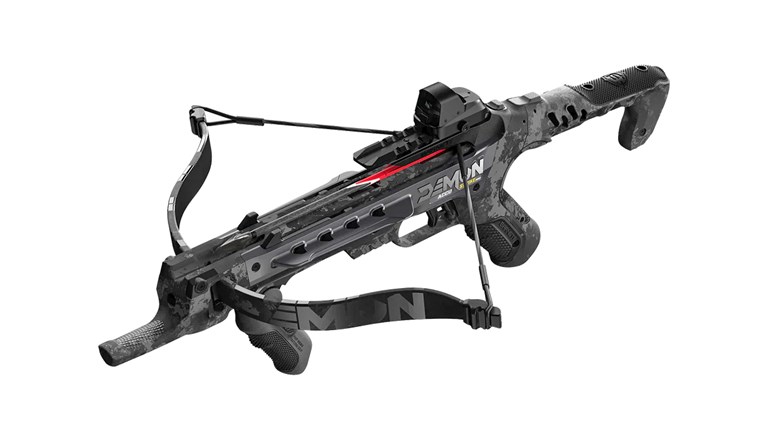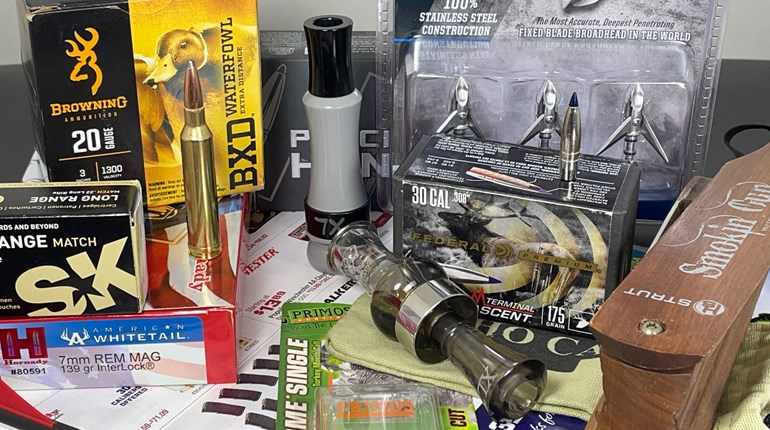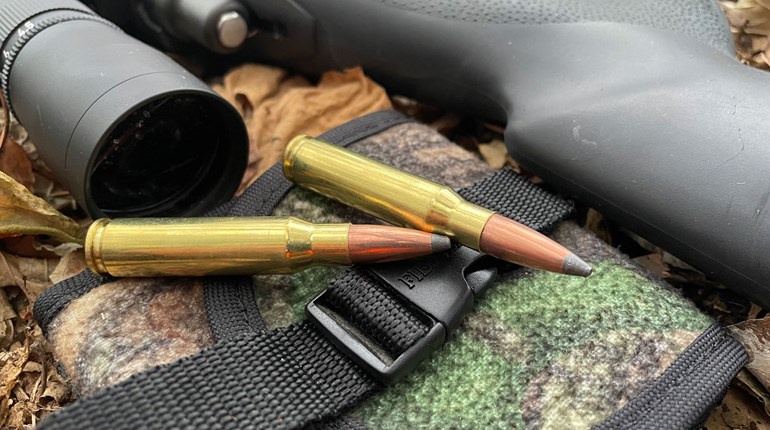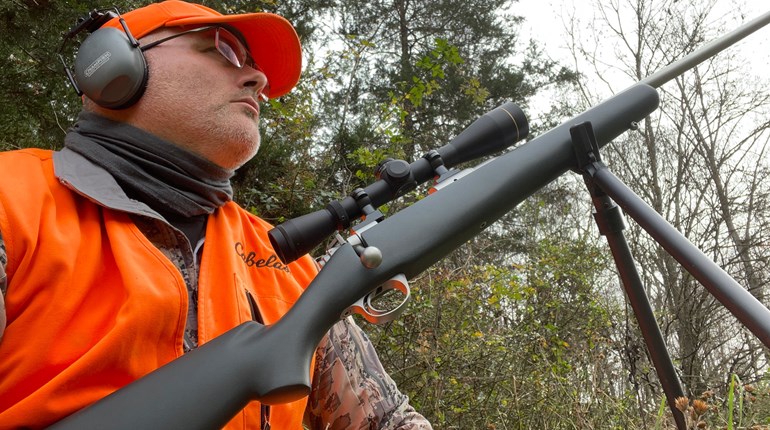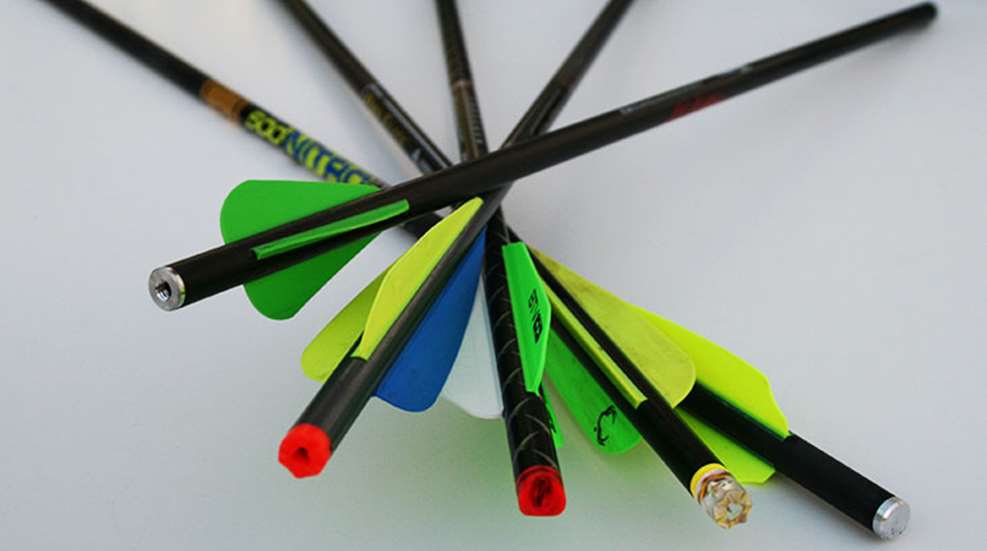
Accompanying crossbows today are the accouterments necessary for firing them—usually a cocking rope/mechanism, bolt-quiver, and of course, a trio or quartet of manufacturer recommended bolts. But, what happens when those bolts are lost, damaged, or provide inadequate downrange performance? It depends. Satisfaction with the manufacturer-provided bolts lends to an easy fix—buy more of what you’re using. But if you’re seeking top-tier performance or a specialized bolt for a particular hunt, the choice is far more difficult. Below is a primer to guide you in making an informed decision when buying crossbow bolts.
Construction
Crossbow bolts are manufactured from several materials, including: carbon/graphite, aluminum and some combination thereof. Each has advantages and disadvantages.
Offered in a variety of weights and tolerances (i.e. straightness) unequalled by those made from aluminum, there’s a carbon bolt to fit every crossbow and one that’s ideal for given hunt parameters. Whether hunting pronghorn antelope on the Wyoming prairies or brown bear on Kodiak Island, Alaska, you’re covered. Best of all, carbon bolts are in one of two conditions; either they’re straight or broken (cracked/splintered). There’s no in-between. Straightness, consistency and a fast recovery lend to top-notch accuracy. However, premium performance comes at a price—expect to pay more for quality carbon bolts than aluminum.
Few in number, aluminum bolts offer crossbow hunters with an economical option at the expense of variety and consistency. Concerning the former, TenPoint Crossbow Technologies and offshoot Wicked Ridge Crossbows have 20-inch aluminum bolts in 436 grs. and 448 grs., respectively. That said, they’re both equipped with TenPoint’s patented Omni-Nock. Straightness is reported to within 0.003-inch—“premium” carbon bolts, by the way, are down to 0.001-inch. Aluminum bolts can produce stellar accuracy; however, due the suppleness of the lightweight metal, recovery from the shot is slower than with carbon, and the bolts can be easily bent. Attentiveness is required.
The bi-material bolt is Easton’s Full Metal Jacket (FMJ) Crossbow. A high-strength carbon core surrounded by a 7075 aluminum jacket creates a bolt that, sans the available brass insert, still weighs 13.7 g.p.i. That heft, when combined with the rigidity afforded through bi-material construction and 0.003-inch straightness, produce a bolt that’s designed for deep penetration on the largest, toughest species. Like carbon bolts, these are costly.
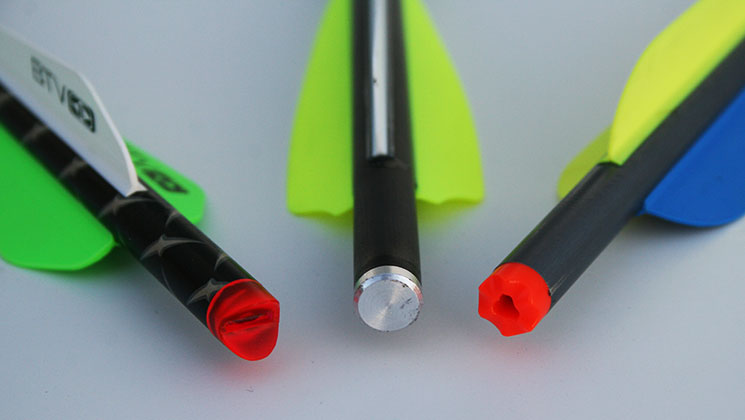
Nock
Crossbows are designed to work with specific nocks, and deviating from them can create calamitous consequences. Take TenPoint Crossbow Technologies’ models for example; they mandate the use of the company’s unique Omni-Nock, which is designed to maintain contact with the string even if the string’s forward movement occurs at (or from) a slight angle. If another nock type—flat, half-moon or “capture,” for instance—is utilized the string could bypass the nock, resulting in a dry-fire. At minimal, the crossbow will be damaged.
Internet threads are rife with suggestions for nock use. Some will push using half-moon nocks on models calling for flat nocks. Typically you can, but there’s a caveat that accompanies doing so. Bolts with half-moon nock have a “cock vane” of differing color that must be placed downward in the flight groove of the rail. Loading the bolt in any other manner will result in a dry-fire, as the string will bypass the nock. Ask yourself this: are you diligent enough to ensure this practice in low light and during moments of high stress? If not, stay clear. Why endanger your crossbow. In reality, best practice is to adhere to the crossbow manufacturers’ recommendations for nock design. Doing so minimizes the risk of an accidental dry-fire.
I also highly recommend using illuminated nocks. They can be worth their weight in gold. Here’s why: Given the velocities at which they’re propelled and their abbreviated lengths, crossbow bolts are extremely difficult to see in flight and are harder than standard arrows to recover after the shot. Concerning the latter, bolt recovery is important for tracking, as well as for leaving the hunting grounds devoid of something that can injure others or damage farm implements and vehicles. Exhaust all options is recovering a fired bolt.
Length
Like nocks, crossbows are designed to work with bolts of specific lengths. Typically, they run from 16 inches to 22 inches, with most measuring from 20 to 22 inches. Again, following manufacturers’ guidelines is best practice. Within reason, a longer bolt can be used in place of a shorter one (such as a 20-inch in a crossbow typically using a 16-inch bolt) but not vice-versa. However, doing so will extend the broadhead further from the front of the crossbow and increase the likelihood that it’s inadvertently contacted by an errant body part—usually a hand or arm.
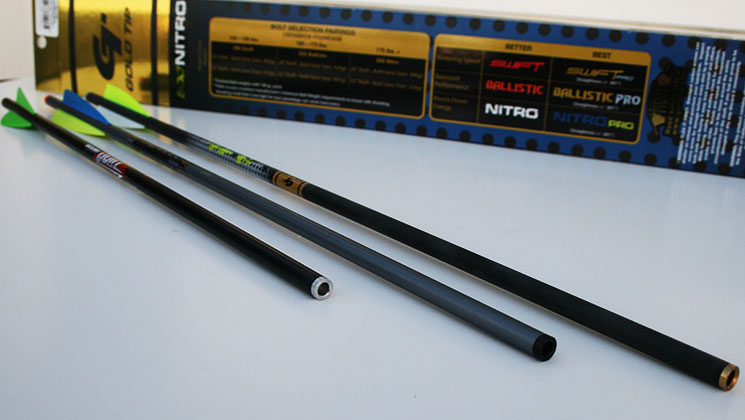
Weight
Weight of the bolt is a paramount decision for several reasons. For starters, shooting a bolt that’s too light for the poundage will likely negatively affect accuracy and could potentially damage the crossbow. Manufacturers provide minimal bolt weights for each model. Don’t drop below that weight. Additionally, bolt makers such as Gold Tip, provide easy-to-understand charts for making the correct choice. For example, for 100-150, 150-175 and 175-lb.-plus weights, the company recommends the 396 Swift, 425 Ballistic and 500 Nitro, respectively. Heavier-than-necessary bolts are safe to shoot but will require an adjustment of your scope to compensate for the trajectory.
An increase in bolt weight—the bolt itself or addition of a heavy, brass insert—is paralleled by growth in kinetic energy. For example, shot from TenPoint Crossbow Technologies’ new Eclipse RCX—which has a 140-lb. draw—a 370-gr. Pro Lite bolt attains 370 fps for 113 ft.-lbs. of kinetic energy (f.p. k.e.). A heftier, 420-gr. Pro 22 bolt at 351 fps produces 115 f.p. k.e., while the still heavier 435-gr. Magnum XX75 bolt at 347 fps has 116 f.p. k.e. An uptick in f.p. k.e. results in an increase in the capacity of the broadhead-tipped bolt to penetrate bodily structures. Numbers fluctuate, but it’s generally accepted that 65 f.p. k.e. is required to kill the largest, heaviest common species, while deer and antelope require less.
More importantly, the heavier (and yet still speedy) bolts carry more momentum and thus penetrate deeper than their lighter, faster counterparts. Ideally, strike a balance between speed and weight for the ideal trajectory and on-target momentum. That being said, lighter bolts might be the ticket for hunting thin-skinned and lightly boned animals, such as antelope, where the shot distances are expected to be longer. Keep in mind that because noise is produced by vibration, by using a heavier bolt—thus reducing vibration—your crossbow will be quieter.
Price
Price is a highly subjective and contentious topic. To me, when considering the money spent on outfitted hunts, travelling, tags and equipment—some of which probably isn’t essential—indulging on high-quality bolts really isn’t a big deal and could save your hunt. You need to ask yourself: Is an extra $10-$20 for “premium” bolts a deal breaker when you’ll probably only get one good shot? In my opinion, it’s not. It’s not a question of whether or not lesser-quality products will fail, but when they’ll do so. I’ve seen it too many times to believe otherwise.
Is this an all-inclusive report about crossbow bolts? No, as topics such as vanes and front of center (FOC) are topics of articles unto themselves. Nonetheless, knowing what you know now, you’re ready to make an informed decision when selecting your next batch of bolts. Choose wisely.












